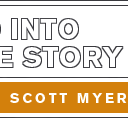Laura, I agree: This is a traditional three-act structure. [NOTE: The script is 160 pages long.] The setup (with an effective montage to introduce all the key players), the trial beginning, as you note, around 30 (Judge Hoffman actually enters the courtroom on 29). It's a lengthy second act. I'll get into a deeper analysis of the plot in tomorrow's post.
One interesting aspect of the script is how Sorkin manages time. He not only uses flashbacks to visualize court testimony - which opens up the trial beyond the confines of the courtroom - it also allows him to explore what writers refer to as the 'unreliable narrator.' For example, there are several instances in which witnesses describe events which we see in flashback are different than their testimony. It's a clever technique.
People often talk about Sorkin being a great writer of dialogue, but I've always been impressed with how he handles story structure. The montage setup... the use of flashbacks... the compression of events and fast-forwarding through actual time... he manages to pull of a lengthy trial and make it feel coherent.
More to come. Thanks, Laura!
